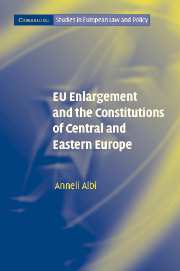Book contents
- Frontmatter
- Contents
- List of tables
- Series Editors' Preface
- Acknowledgements
- Table of cases
- Table of treaties, laws and other instruments
- List of abbreviations
- Introduction
- 1 Overview of the accession process
- 2 Constitutional adaptations in the ‘old’ Member States
- 3 Some idiosyncrasies of CEE constitutions
- 4 Constitutional issues in the pre-accession period
- 5 Revision of CEE constitutions for EU membership
- 6 Theoretical views of sovereignty and democratic legitimacy in CEE
- 7 Referendums
- 8 Membership of NATO and other international organisations
- 9 Role of Constitutional Courts
- 10 Implications of the European Constitution
- Epilogue: ‘Taking constitutions seriously’ in the process of European integration
- Bibliography
- Appendix
- Index
4 - Constitutional issues in the pre-accession period
Published online by Cambridge University Press: 28 July 2009
- Frontmatter
- Contents
- List of tables
- Series Editors' Preface
- Acknowledgements
- Table of cases
- Table of treaties, laws and other instruments
- List of abbreviations
- Introduction
- 1 Overview of the accession process
- 2 Constitutional adaptations in the ‘old’ Member States
- 3 Some idiosyncrasies of CEE constitutions
- 4 Constitutional issues in the pre-accession period
- 5 Revision of CEE constitutions for EU membership
- 6 Theoretical views of sovereignty and democratic legitimacy in CEE
- 7 Referendums
- 8 Membership of NATO and other international organisations
- 9 Role of Constitutional Courts
- 10 Implications of the European Constitution
- Epilogue: ‘Taking constitutions seriously’ in the process of European integration
- Bibliography
- Appendix
- Index
Summary
Europe Agreements in CEE legal orders
The main legal basis for the relationship between the EU and CEE has lain in the Europe Agreements, which created an association between the EU and each individual country. The Europe Agreements established a free trade area in industrial goods, provided a general framework for political dialogue, and established the basis for cooperation in various other fields, such as industry, environment, technology, science and education. They also provided a framework for the EU's financial and technical assistance to these countries. Central to the Agreements was the obligation to harmonise the countries' legislation with EC law; the Agreements specified the areas of priority, which mainly lay in internal market and competition. The Europe Agreements were first concluded with the Vishegrad countries – Poland, Hungary and the Czechoslovak Federation in 1991 – followed in 1993 by Romania, Bulgaria and, after the dissolution of the Czechoslovak Federation, Slovakia and the Czech Republic. The Europe Agreements with Estonia, Latvia and Lithuania were signed in 1995, and with Slovenia in 1996. For the eight CEE accession countries, the Europe Agreements ceased to exist as of 1 May 2004, but they continue to be in force with regard to Romania and Bulgaria.
This section explores in hindsight the position and application of the Europe Agreements in CEE legal orders, as this experience continues to be of relevance for current and future candidate countries.
- Type
- Chapter
- Information
- Publisher: Cambridge University PressPrint publication year: 2005



